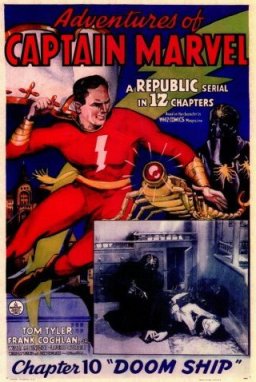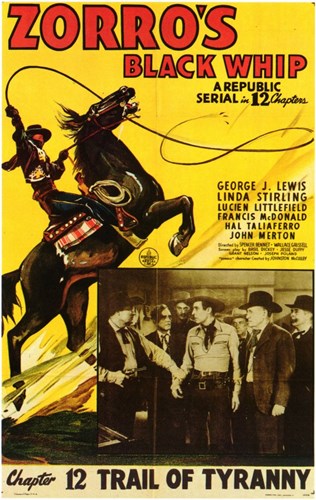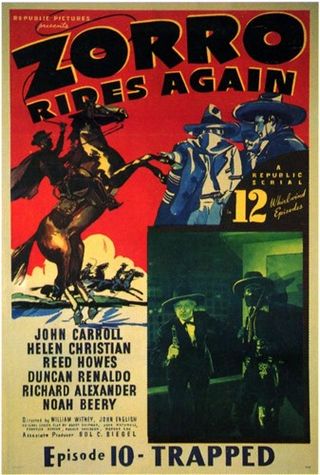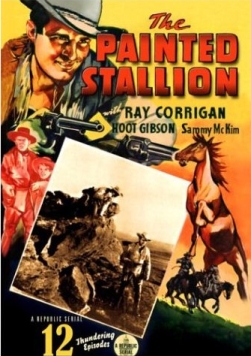
Adventures of Captain Marvel is a 1941 American 12-chapter black-and-white movie serial from Republic Pictures, produced by Hiram S. Brown, Jr., directed by John English and William Witney, that stars Tom Tyler in the title role of Captain Marvel and Frank Coghlan, Jr. as his alter ego, Billy Batson. The serial was adapted from the popular Captain Marvel comic book character, then appearing in the Fawcett Comics publications Whiz Comics and Captain Marvel Adventures. The character is now owned by DC Comics and is known as Shazam.

The Great Alaskan Mystery is a 1944 Universal film serial about government agents trying to stop Nazi spies from getting their hands on futuristic weapons.

Zorro's Black Whip is a 1944 12-chapter film serial by Republic Pictures starring Linda Stirling. The film was made after the 1940 20th Century-Fox remake of The Mark of Zorro in order to capitalize on it. Republic was not able to use the character of Zorro himself, however, and despite the title, the hero(ine) is called The Black Whip throughout.

Daredevils of the Red Circle (1939) is a 12-chapter Republic Movie Serial starring Charles Quigley, David Sharpe, Herman Brix, Carole Landis, Miles Mander and Charles Middleton. It was directed by William Witney and John English and is considered one of the better serials produced by Republic. The serial was the fourteenth of the sixty-six serials produced by the studio.

The Fighting Devil Dogs (1938) is a 12-chapter Republic movie serial starring Lee Powell and Herman Brix, the latter better known by his later stage name, Bruce Bennett. It was directed by William Witney and John English. While not often considered a great serial, as it contains much stock footage and two recap chapters, it is famous for its main villain, the Lightning—the first costumed supervillain. There is some speculation that George Lucas used the Lightning as a template for Darth Vader.

Zorro Rides Again (1937) is a 12-chapter Republic Pictures film serial. It was the eighth of the sixty-six Republic serials, the third with a Western theme and the last produced in 1937. The serial was directed by William Witney & John English in their first collaboration. The serial starred John Carroll who also sang the title song as a modern descendant of the original Zorro with Carroll stunt doubled by Yakima Canutt. The plot is a fairly standard western storyline about a villain attempting to illicitly take valuable land. The setting is a hybrid of modern (1930s) and western elements that was used occasionally in B-Westerns. It was also the first in a series of five Zorro serials, followed by Zorro's Fighting Legion (1939), Zorro's Black Whip (1944), Son of Zorro (1947) and Ghost of Zorro (1949).

Dick Tracy's G-Men (1939) is a 15-Chapter Republic movie serial based on the Dick Tracy comic strip by Chester Gould. It was directed by William Witney and John English.

King of the Royal Mounted (1940) is a Republic Pictures northern serial based on the King of the Royal Mounted comic strip directed by William Witney and John English.

Darkest Africa (1936) is a Republic movie serial. This was the first serial produced by Republic Pictures and was a loose sequel to a Mascot Pictures serial called The Lost Jungle, also starring Clyde Beatty. Mascot, and other companies, had been taken over in 1935 by Consolidated Film Laboratories and merged to become Republic. Producer Nat Levine was formerly the owner of Mascot Pictures.

The Vigilantes Are Coming is a 1936 American Republic film serial directed by Ray Taylor and Mack V. Wright. It was the third of the sixty six serials made by Republic Pictures.

The Painted Stallion is a 1937 American Western film serial from Republic Pictures. It was the sixth Republic serial of the sixty-six made by that company. Western serials such as this made up a third of the serials from Republic, a studio that was also heavily involved in making B-Western feature films at the time.

The Lone Ranger Rides Again is a 1939 American Republic serial. It was a sequel to Republic's 1938 serial The Lone Ranger, which had been highly successful, and the thirteenth of the sixty-six serials produced by Republic.

Dick Tracy vs. Crime, Inc. (1941) is a Republic Movie serial based on the Dick Tracy comic strip. It was directed by the team of William Witney and John English with Ralph Byrd reprising his role from the earlier serials. It was the last of the four Dick Tracy serials produced by Republic, although Ralph Byrd went on to portray the character again in two features and on television.

Haunted Harbor (1944) is a Republic serial, based on the novel by Ewart Adamson.

Daughter of Don Q (1946) is a Republic Movie serial. It combines elements of the B-Western genre with contemporary crime films, especially the popular "land grab" plot in which the villain attempts to steal apparently worthless land from the heroine because he secretly knows it is worth a fortune. In this case, Dolores Quantero, is the rightful heir to extremely valuable metropolitan land which another family member, Carlos Manning, wants for himself.

Son of Zorro is a 1947 American Western film serial from Republic Pictures. It was the 43rd of the 66 serials produced by that studio. The serial was directed by Spencer Gordon Bennet and Fred C. Brannon. George Turner starred as a descendant of the original Zorro in 1860s United States.

Ghost of Zorro is a 1949 Republic Movie serial. It uses substantial stock footage from earlier serials, including Son of Zorro and Daredevils of the West. This film was shot in Chatsworth, Los Angeles.

Don Daredevil Rides Again (1951) is a Republic Movie serial. It makes heavy use of stock footage from Republic's previous Zorro serials. The character of Don Daredevil was created for this serial as the rights to Zorro belonged to Disney by 1951.

Government Agents vs Phantom Legion (1951) is a 12-chapter American black-and-white action film serial produced and distributed by Republic Pictures Corporation in 1951. It is an original, studio-commissioned screenplay by Ronald Davidson, produced by Franklin Adreon and directed by Fred C. Brannon.

King of the Carnival is a 1955 Republic movie serial that contains a substantial amount of stock footage from the earlier Republic serial Daredevils of the Red Circle. It is the 66th and final serial produced by Republic and is often considered to be among the studio's worst. The plot concerns treasury agents investigating a Cold War counterfeiting operation believed to be connected to a circus.














